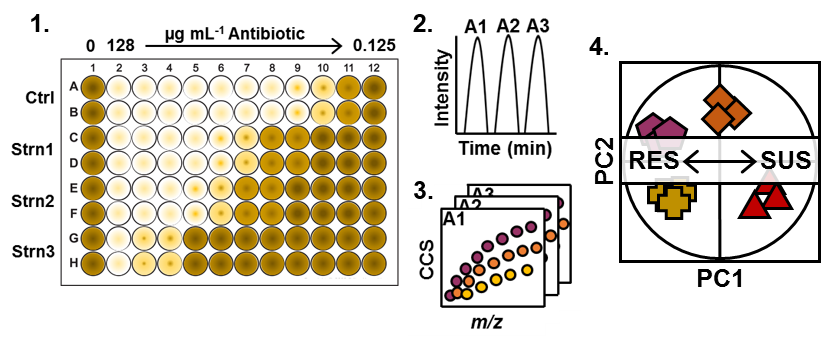Research in the Hines Lab bridges chemistry and biology. We are developing novel bioanalytical methods based on ion mobility-mass spectrometry and applying these methods to study important concerns in human health like antibiotic resistance. Some of our ongoing research projects are listed below.
HIGH-THROUGHPUT SCREENING with IM-MS
Our lab is developing high-throughput screening methods using ion mobility-mass spectrometry (IM-MS). The rapid nature of gas-phase IM separations allows us to run more samples in less time and increase the complexity of the studies we can perform (i.e., more conditions, more concentrations, more molecules tested). The goal is to maintain the inherent complexity of biological samples and use all the molecules present, including lipids and metabolites, to evaluate the system or develop a model. Currently, the Hines Lab is developing these methods for the study of antibiotic resistance. Applications include antibiotic susceptibility testing and screening for therapeutic combinations of small molecules.
Integrated APPROACHes to OMICS ANalyses
The molecules of life all derive from a handful of core, or central, metabolic pathways. While we often look at just one group of molecules, such as lipids or metabolites, the changes observed in those “omes” may not be independent of one another. The Hines Lab is using IM-MS as an approach to integrated omics by maintaining the natural complexity in biological samples. We’re also interested in isotope labeling approaches to explore the connections between metabolomics and lipidomics and bioinformatics tools for combining metabolomics and lipidomics with genomics data. The goal is to map these data onto pathways to get a better sense of the system as a whole.
NEW TOOLS and APproaches to fighting ANTIBIOTIC RESISTANCE
We’re using our analytical tools to study the biochemical processes that are altered in antibiotic resistance. Our goal is to identify small molecules that have therapeutic effects on their own or increase the susceptibility to existing therapeutics. The high-throughput IM-MS platform is key to this project, serving as both an approach to screening for effective small molecules and identifying the signatures of susceptibility and resistance to these therapeutics.



